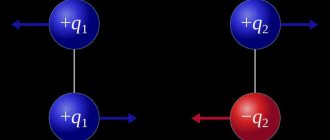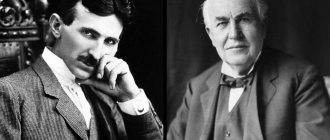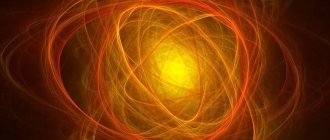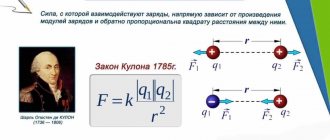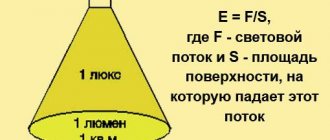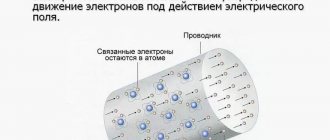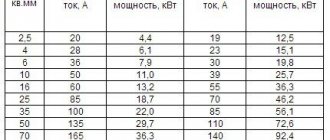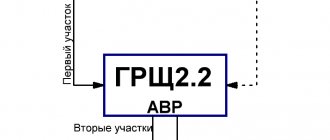- home
- Directory
- Physics
Electric current in any part of the circuit does work ($A$).
Let's consider an arbitrary section of the circuit to the ends of which a voltage $U$ is applied. If the current strength in our section is equal to $I$, then during a period of time $\Delta t$ a charge of magnitude $\Delta q=I\Delta t$ will pass through this section. Consequently, the work done by the electric current in the area under consideration will be equal to: \[A=UI\Delta t\left(1\right).\]
Formula (1) is satisfied for an arbitrary section of the circuit containing any load, if the current strength is constant. By definition, any power ($P$) is a quantity that characterizes the rate of energy conversion or the rate of work done:
\[P=\frac{A}{\Delta t}\left(2\right).\]
If we use a particular definition of the work of the electric field (1), we obtain the definition of electric power:
\[P=UI\left(3\right).\]
Electricity unit of measurement
Voltage
The voltage (U) in the network is measured in volts (V).
In a single-phase network, which is usually used to supply electricity to private consumers, the voltage is 220V.
In a three-phase network the voltage is 380V. 1 kilovolt (kV) is equal to 1000V.
Voltage 220 and 380V is equivalent to voltage designation as 0.22 and 0.4 kV.
Current strength
The consumed load produced by household appliances, equipment and other consumers is called current strength (I) and is measured in amperes (A).
Resistance
Resistance (R) is an equally important indicator and demonstrates the amount of resistance of materials to the passage of electric current. In everyday life, measuring resistance indicates the integrity of electrical appliances, measured in (Ohm). To measure a large resistance value, for example, when measuring the integrity of an electric motor, use a megger; 1 ohm is equal to 0.000001 megaohm (mOhm).
1 kiloohm (kOhm) is equal to 1000 Ohm.
The resistance of the human body ranges from 2 to 10 kOhm.
The resistivity of the conductor is used to evaluate the resistance of materials for their subsequent use in the manufacture of electrical products; it depends on the cross-sectional area and length of the conductor.
Power
Power is the amount of electrical energy consumed by a particular household appliance for a certain unit of time, measured in watts (W) and kiloW (kW) - 1000 W; on an industrial scale, such units of measurement as megawatt - 1 million W and gigawatt ( gW) – 1 billion watts.
Methods used
Electrical quantities are measured using various methods, which can also be classified according to the following criteria:
- The type of physical phenomena on the basis of which the measurement is carried out (electrical or magnetic phenomena).
- The nature of the interaction of the measuring instrument with the object. Depending on it, contact and non-contact methods of measuring electrical quantities are distinguished.
- Measurement mode. In accordance with it, measurements can be dynamic and static.
- Method of making measurements. Both direct assessment methods have been developed, when the desired value is directly determined by a device (for example, an ammeter), and more accurate methods (zero, differential, opposition, substitution), in which it is revealed by comparison with a known value. Compensators and electrical measuring bridges of direct and alternating current serve as comparison devices.
How is electricity measured on the meter?
To determine the amount of electricity consumed , electric active energy meters are used, they serve to account for it. There are also reactive energy meters in industry.
To determine how electricity consumption in an apartment is measured, 1 kW*hour is used. For reactive energy meters, integrated reactive power is measured as 1 kVar*hour. It should be noted that when recording the energy consumed, the meter must be written correctly, the power multiplied by the time.
Kilowatt hour
(
kW
⋅
h
) - a non-system unit of measurement of the amount of energy produced or consumed, heat, as well as mechanical work performed.
It is used primarily for measuring electricity consumption in everyday life, the national economy and for measuring electricity production in the electric power industry [1].
Characteristics of measuring instruments
Measuring equipment devices have certain properties that are important for performing their immediate functions. These include:
- Metrological characteristics, such as sensitivity and its threshold, measurement range of an electrical quantity, instrument error, division value, speed, etc.
- Dynamic characteristics, for example, amplitude (dependence of the amplitude of the device’s output signal on the input amplitude) or phase (dependence of the phase shift on the signal frequency).
- Performance characteristics reflecting the degree of compliance of the device with the operating requirements under certain conditions. These include properties such as reliability of readings, reliability (operability, durability and reliability of the device), maintainability, electrical safety, and efficiency.
The set of characteristics of the equipment is established by the relevant regulatory and technical documents for each type of device.
Definition [edit | edit code]
A kilowatt-hour is equal to the amount of energy consumed (produced) by a one-kilowatt device in one hour. Since 1 W⋅s = 1 J, 1 kW⋅h = 1000 W ⋅ 3600 s = 3.6 MJ
.
Writing [edit | edit code]
It should be noted that the correct spelling is “kWh” (power times time). The spelling "kW/h" (kilowatt per hour), often used in many media and even sometimes in official documents, is incorrect.
The physical meaning of the unit of measurement “kW/h” is the rate of change of power: “by how many kilowatts will the electrical power consumed or generated by the device change in 1 hour.” If we draw an analogy with mechanics, the difference between the units of measurement “kWh” and “kWh” is the same as between distance and acceleration. Although such a parameter may have practical applications - for example, to characterize the ability of a power plant to quickly adjust to changes in load - it cannot, by definition, serve as a unit of measurement of the amount of energy.
Concept of measurements
The measurement of any physical quantity is made by comparing it with a certain quantity of the same type of phenomenon, adopted as a unit of measurement. The result obtained from the comparison is presented numerically in appropriate units.
This operation is carried out using special measuring instruments - technical devices that interact with the object, certain parameters of which need to be measured. In this case, certain methods are used - techniques through which the measured value is compared with the unit of measurement.
There are several signs that serve as the basis for classifying measurements of electrical quantities by type:
- Number of measurement acts. What matters here is whether they are once or twice.
- Degree of accuracy. There are technical, control and verification measurements, the most accurate measurements, as well as equally accurate and non-equally accurate.
- The nature of the change in the measured quantity over time. According to this criterion, measurements can be static and dynamic. Through dynamic measurements, instantaneous values of quantities that change over time are obtained, and through static measurements, some constant values are obtained.
- Presentation of the result. Measurements of electrical quantities can be expressed in relative or absolute form.
- A method for obtaining the desired result. According to this criterion, measurements are divided into direct (in which the result is obtained directly) and indirect, in which quantities related to the desired value by some functional dependence are directly measured. In the latter case, the desired physical quantity is calculated from the results obtained. Thus, measuring current using an ammeter is an example of a direct measurement, and power is an example of an indirect one.
Conversion to other energy units [edit | edit code]
Energy unit conversion table
| joule | watt-hour | electron-volt | calorie | |
| 1 kg⋅(m/s)² = 1 W⋅s | 1 | 2,78⋅10 −4 | 6,241⋅10 18 | 0,239 |
| 1 kWh | 3,6⋅10 6 | 1000 | 2,247⋅10 25 | 8,60⋅10 5 |
| 1 eV | 1.6⋅10 −19 | 4,45⋅10 −23 | 1 | 3,827⋅10 −20 |
| 1 cal | 4,1868 | 1,163⋅10 −3 | 2,613⋅10 19 | 1 |
- 1 thousand kWh = 859.8452 Mcal = 0.86 Gcal.
- 1 thousand kWh = 3.6 GJ
- 1 kcal = 1.163 Wh
When calculating the energy consumed by various electrical appliances, units such as watt and kilowatt-hour are often used. They are similar in name and are used in the same area. However, in reality these units differ from each other in many ways. If power is measured in watts, then kWh shows how much energy was consumed by the device during a certain period of its operation.
Electrical measuring instruments: types and features
Measuring basic electrical quantities requires a wide variety of instruments. Depending on the physical principle underlying their work, they are all divided into the following groups:
- Electromechanical devices necessarily have a moving part in their design. This large group of measuring instruments includes electrodynamic, ferrodynamic, magnetoelectric, electromagnetic, electrostatic, and induction instruments. For example, the magnetoelectric principle, which is used very widely, can be used as the basis for devices such as voltmeters, ammeters, ohmmeters, and galvanometers. Electricity meters, frequency meters, etc. are based on the induction principle.
- Electronic devices are distinguished by the presence of additional units: converters of physical quantities, amplifiers, converters, etc. As a rule, in devices of this type the measured quantity is converted into voltage, and their structural basis is a voltmeter. Electronic measuring instruments are used as frequency meters, capacitance, resistance, inductance meters, and oscilloscopes.
- Thermoelectric devices combine in their design a magnetoelectric type measuring device and a thermal converter formed by a thermocouple and a heater through which the measured current flows. Devices of this type are used mainly for measuring high-frequency currents.
- Electrochemical. The principle of their operation is based on processes that occur on the electrodes or in the medium under study in the interelectrode space. Instruments of this type are used to measure electrical conductivity, the amount of electricity and some non-electrical quantities.
You will be interested: Stefan Batory: biography, years of life, reign, wars
Based on their functional features, the following types of instruments for measuring electrical quantities are distinguished:
- Indicating (signaling) devices are devices that allow only direct reading of measurement information, such as wattmeters or ammeters.
- Recording - devices that allow the recording of readings, for example, electronic oscilloscopes.
Based on the type of signal, devices are divided into analog and digital. If the device produces a signal that is a continuous function of the quantity being measured, it is analog, for example a voltmeter, the readings of which are given using a dial with a pointer. In the event that the device automatically generates a signal in the form of a stream of discrete values, which is supplied to the display in numerical form, we speak of a digital measuring instrument.
Digital devices have some disadvantages compared to analog ones: less reliability, need for a power source, higher cost. However, they are also distinguished by significant advantages that, in general, make the use of digital devices more preferable: ease of use, high accuracy and noise immunity, the possibility of universalization, combination with a computer and remote signal transmission without loss of accuracy.
Watt, kilowatt and kilowatt-hour
The unit of measurement watt got its name in honor of the scientist James Watt, who studied electricity in the nineteenth century. It is he who is credited with the invention of the universal steam engine.
Today, any power is measured in watts, not just electrical power. For example, to measure the power of a car engine, watts are also used along with horsepower. However, most often it is not the “watt” itself that is used, but its derivative, the kilowatt (kW). By analogy with the meter and kilometer, as well as with the gram and kilogram, one kilowatt is equal to a thousand watts.
Energy is often also calculated in other units, multiples of the watt. For example, to measure high power it is convenient to use the megawatt, a unit that corresponds to a million watts. You can also use other prefixes of the international system of units, including those that correspond to tenths, hundredths, thousandths.
- deciwatt is a tenth of a watt;
- centiwatt - its hundredth part;
- A milliwatt is a thousandth of a watt.
The electric power that is consumed by ordinary household appliances such as lamps, refrigerators, and TVs is best measured in kW. If the watt and its derivative units are included in the SI system, then the kilowatt-hour is not there. KWh is a unit of measurement that is non-systemic. It was created only to keep track of the electrical energy produced or, conversely, used.
Application of value
According to GOST, kWh is the basic unit for keeping records of the amount of electrical energy used. Its main advantage is ease of use. The results when using it are the most acceptable. However, no one prohibits using multiple units if necessary, for example, megawatt-hour, gigawatt-hour.
GOST also established rules for writing the unit of measurement - “kilowatt-hour”. Its full name must be written using a hyphen. If a short designation in English or Russian letters is used, then before “h” and “ch” you need to put a dot in the middle of the line. In essence, such a point is a multiplication sign.
The power of devices powered by electricity, as well as the energy they consume per hour, is usually indicated on their body. In this case, the unit “watt” can be designated by the English letter “W”. The choice of one or another derived unit depends on the manufacturer.
You can often see household microwave ovens produced by different companies, the power and energy consumption of which are indicated on the housings in different units of measurement.
This could be kW-hours, kW, or even volt-amps. For example:
- If the designation “kW”, “kW” or “kVt” is present on the body of the microwave oven, then the thermal power of this device can be judged by the number located in front of them.
- If the symbols “kWh” and “kW h” are present on the case, this means that the manufacturer of the microwave oven has decided to indicate the electrical power that the device consumes during a certain period of its operation.
Development of electrical measuring instruments and methods
The wide variety of means for measuring electrical quantities is due to many different phenomena in which these parameters play a significant role. Electrical processes and phenomena have an extremely wide range of use in all industries - it is impossible to specify an area of human activity where they would not find application. This determines the ever-expanding range of problems of electrical measurements of physical quantities. The variety and improvement of means and methods for solving these problems is constantly growing. The area of measurement technology such as measuring non-electrical quantities using electrical methods is developing especially quickly and successfully.
Modern electrical measuring technology is developing in the direction of increasing accuracy, noise immunity and speed, as well as increasing automation of the measuring process and processing of its results. Measuring instruments have evolved from the simplest electromechanical devices to electronic and digital devices, and then to the latest measuring and computing systems using microprocessor technology. At the same time, the increasing role of the software component of measuring devices is obviously the main development trend.
Source
Calculation features
Despite the fact that the power of electrical appliances is often indicated on their cases, you still often have to independently calculate how much electricity a particular household appliance consumes. In order not to make mistakes when calculating and to come to the correct result, you need not only to know about the differences between kW and kW-hours, but also to be able to convert these values from one to the other. For example, power often needs to be converted into energy and vice versa.
Before you start calculating the energy consumed by a particular household electrical appliance, you need to prepare a calculator, since the numbers may turn out to be such that it will be quite difficult to operate with them in your head.
Before converting power into energy, that is, kW per kWh, it is necessary to clarify what was previously measured. If the meter readings were measured, then everything will be extremely simple. It is enough just to correct “kilowatt” to “kilowatt-hour”.
The meter reading is the energy consumed by electrical appliances per unit of time. It is also measured in kilowatt-hours. It’s just that in everyday life the name of this unit has lost the word “hour”. As a result, it became abbreviated to simply kW. Quite often, owners of any household electrical appliance convert kW to kW-hours in order to determine how much energy is consumed during its operation and, therefore, how often it needs to be turned on.
If the device consumes too much energy, you will have to use it rarely to save energy. In order to accurately determine how much energy this or that equipment, for example, an electric heater, will require, you need to know its operating time and power, which is usually indicated on the housing. For example, if the power of the device is 2 kW, and it works for 3 hours, then as a result of simple mathematical multiplication you can find out that the total electricity consumption during this time is 6 kilowatt-hours.
Electricity power
The amount of work done by electric current per unit time is called power. It is converted into various types of energy: mechanical, thermal, etc. In circuits with direct and alternating currents, it is calculated in various ways. In most cases, there is no need to calculate it, since it is indicated on the electrical equipment (on the housing and in the documentation). Calculation is necessary only when designing devices.
Basic relationships
In a direct current circuit, the power formula is written as follows: P = I * U. There are other ratios obtained from Ohm’s law (I = U / R):
- For a chain section: P = sqr (I) * R = sqr (U) / R.
- For a complete circuit (taking into account EMF - e), the equality is written as follows: P = I * e = I * e - sqr (I) * Rin = I * (e - (I * Rin)).
- P = I * (e + (I * Rin)).
In the second case, the formula must be applied provided that there is an electric motor in the circuit or the battery is being charged, i.e., electricity is consumed. If there is a generator or galvanic cell in the electrical circuit, since energy is released, the last formula should be used. These relationships cannot be applied to circuits that consume alternating current. The main reason is its characteristics, which change over time according to a certain law.
In physics, there are three types of power that depend on the elements: active (resistor), reactive (capacitance and inductance) and total. Active power is calculated using the following formula: Pa = I * U * cos (a). The ratio takes into account the values of U and I, which are root mean square, as well as the cosine of the phase angle between them. Reactive power is found similarly, only instead of cosine, sine should be used: Qр = I * U * sin (a). With an inductive load in the circuit, the value is Qp>0, and with a capacitive load, Qp<0. The International System of Units (SI) unit of power is the watt (abbreviated W).
You might be interested in this: Digital multimeter and multitester measurement
Physical meaning of watt
The physical meaning of a watt is as follows: the consumption of electricity over a certain time. Therefore, 1 W is the consumption of 1 joule (J) of electrical energy in 1 second. In other words, a kilowatt kettle consumes 1000 J of electrical energy per unit of time. For the convenience of calculations, special prefixes are used: milliwatt (mW, mwatt), kilowatt (kW or kwatt), megawatt (MW, Mwatt), gigawatt (GW, Gwatt), etc.
Watt is related to other quantities by the following equation: 1 W = 1 J/s = (1 kg * sqr (m)) / (c * sqr (c)) = 1 N * m / s = 746 l. With. The last value is electrical horsepower. Numerical values of prefixes can be found in technical reference books, as well as on the Internet. For example, 1 kW is equal to 1000 W. The prefix “k” means that the number in front of it should be multiplied by 1000. In order to convert 1 MW, you should multiply the number by the value of the prefix: 1 * 1000000 = 1000000 W = 1000 kW. If you need to convert Watts to kW, then you need to divide the number of watts by 1000.
To account for the consumption of electricity, a unit called watt-hour (Wh) is adopted. The values of Wh and W are different. Watt is power, and Watt-hour stands for the amount of electricity consumed per unit of time. It is very important to correctly write and decipher the last value of Wh (multiplication, not division). The difference between W and Wh can also be determined by calculation. For example, it is necessary to calculate the electricity consumption for 30 minutes for an electrical appliance with a power of 2.5 kW. The calculation procedure is as follows:
- The time should be converted to hours: 30/60 = 0.5 (hours).
- Perform the calculation using the formula: Pch = P * t = 2.5 * 0.5 = 1.25 (kilowatt-hour is written - kW*h).
Decoding the calculation result means that in 30 minutes the device will consume 1.25 kWh or 1250 W (1.25 * 1000 = 1250). If you need to calculate the amount of power consumed by a 100 W incandescent lamp for 20 hours, then you need to substitute the values into the formula: 100 * 20 = 2 kWh.
Thus, power and the amount of electrical energy consumed are different physical quantities that are quite simply calculated. Calculations help determine the amount of electricity and help in saving money.
Energy consumption of some devices
An electric stove with a power of 2 kW will consume energy equal to 1 kWh in half an hour of operation. An ordinary lamp with a power of 100 W, when turned on daily for 8 hours, will consume energy equal to 24 kilowatt-hours per month. If instead of this lamp in the same mode you use an energy-saving lamp with a power of 20 W, then the monthly energy consumption for lighting will be reduced by 5 times. The energy consumption of such a lamp per month will be 4.8 kWh.
Using kilowatt-hours, not only energy consumption is measured, but also, conversely, electricity output. For example, a battery with a capacity of 50 Ah and a voltage of 12 volts is capable of generating energy equal to 0.6 kWh.
It is important not to confuse the power of an electrical appliance, which is measured in ordinary watts or kilowatts, with the energy consumption of this device, which is measured in kilowatt-hours. Despite the similarity of the names of these units and the fact that they are used in the same area, there is a big difference between them.
